CLICCS project A1: Institute of Soil Science ´s Contribution

UHH/IfB/E. Wilcox
Project Description
The CLICCS subproject A1 (Carbon Dynamics in the Arctic) investigates the contribution of arctic ecosystems to the global carbon cycle. Roughly three times the amount of carbon present in the atmosphere is currently stored in permafrost soils, which are thawing and releasing more carbon into the atmosphere as the climate warms. There are a multitude of interacting environmental factors that affect the net greenhouse gas flux from permafrost soils, making is unclear how much carbon will be released to the atmosphere as permafrost thaws. In this project, our institute works in partnership with the Max-Planck Institute for Meteorology using a combination of field, laboratory, and modelling techniques across a wide spatial and temporal scales to improve our ability to estimate the future carbon contribution of the Arctic to the atmosphere.
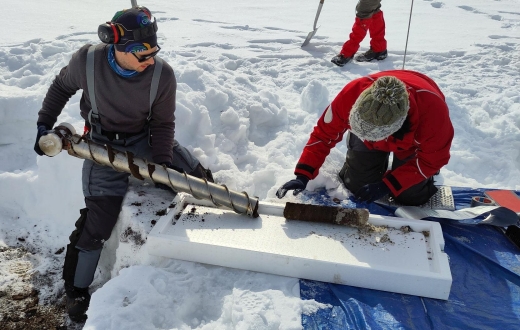
UHH/IfB/C. Knoblauch
The Institute of Soil Science’s contribution to the project builds on its decades-long legacy of Arctic field studies that focused on carbon-turnover processes in permafrost-affected ecosystems. As a part of this project, new field studies and research infrastructure are being established in Blæsedalen on Disko Island, Greenland, using the Arctic Station in Qeqertarsuaq for laboratory work and logistic operations. Blæsedalen is a typical glacial valley of Disko Island, including dry upland tundra, alluvial soils, wetlands, and a variety of microtopographical features.
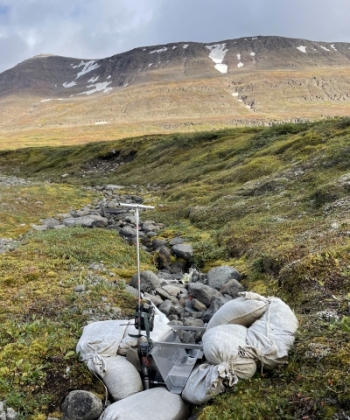
UHH/IfB/E. Wilcox
To measure the lateral carbon flux, we installed a flume within a representative headwater stream that runs from the top of a mountain down to the Røde Elv, the river running along the floor of Blæsedalen. The flume’s specific dimensions allow us to use a water level recorder to calculate the volume of water discharging from the stream every 15 minutes. Like the eddy covariance tower, measuring lateral carbon fluxes also involves measuring the medium in which the carbon is situated; air in the case of vertical carbon fluxes, while water moves carbon laterally as surface and subsurface runoff into streams, rivers, and eventually the ocean. In 2025, we will install an OsmoSampler at the flume that collects water continuously in a narrow tube. In autumn, we will take the OsmoSampler out of the stream and separate the tube into lengths that roughly correspond to one day’s worth of water, allowing us to measure the change in carbon concentration in the water over time.
Our research in Blæsedalen is focused on quantifying vertical and horizontal fluxes of carbon, while also investigating the environmental properties (e.g. soil moisture, topographic position, weather) that influence such fluxes. To measure vertical carbon fluxes, we employ two methods. Since 2022, we have measured vertical carbon fluxes using manual chambers that are placed on collars installed in varying soil and vegetation types. Changes in CO2 and CH4 concentration are recorded by a portable gas analyzer connected to the chamber, and later analyzed to calculate the amount of each gas being released or taken up by the soil. In March 2025, we have installed an eddy covariance tower that continuously measures atmospheric CO2 and 3-D wind speed ten times per second, which can then be used to estimate the vertical carbon dioxide flux for an area roughly 300 m surrounding the tower. Generally, manual chamber measurements are useful for providing information about spatial variability in vertical carbon fluxes at fine scales, while the continuously-running eddy covariance tower provides information about temporal variability.
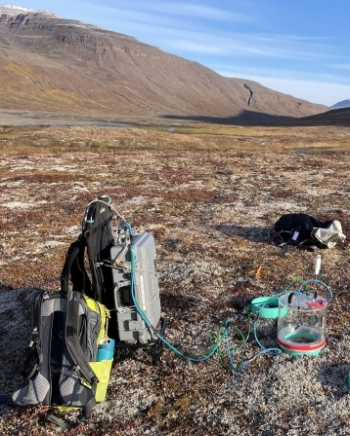
UHH/IfB/E. Wilcox
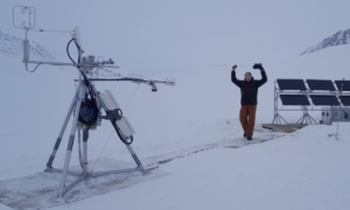
UHH/IfB/D. Holl
We are also conducting intensive soil coring within Blæsedalen to better understand how melting snow interacts with soil water and carbon. After coring soils before and after snowmelt at different soil types and topographic positions, we measure the amount of water stored in soils at different depths, and also extract water samples to analyze the isotope concentration and chemical properties of the soil water. We can then estimate the contribution of snowmelt water to the total change in soil water content, and explore the soil and topographic characteristics that may be linked to snowmelt input into soil. By combining this information with water isotope concentrations collected by the OsmoSampler, we can begin to get a clearer picture of how snowmelt and carbon moves through soils and into streams.
We are also involving Qeqertarusaq residents in our work by training and hiring them to conduct field measurements, and through outreach at local events where it is possible for our work to be presented in Kalaallisut (Greenlandic). This is done with the help of the Arctic Station, which was established in Qeqertarsuaq over 100 years ago.
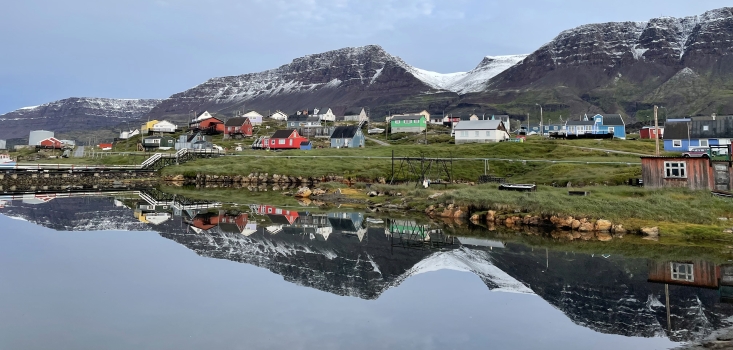
UHH/IfB/E. Wilcox
Staff at the Institute of Soil Science
- CLICCS A1 Co-Chair: Prof. Dr. Lars Kutzbach
- Senior Scientist: Dr. Christian Knoblauch
- Scientist: Dr. Claudia Fiencke
- Scientist: Dr. David Holl
- Research associate: Dr. Minjung Kwon
- Research Associate: Dr. Joseph Tamale
- Research Associate: Dr. Evan J. Wilcox
- Scientific programmer: Dr. Xavier Rodriguez
- Duration: 2019/01 - 2025/12
- Project lead: Prof. Dr. Lars Kutzbach
- Sponsor: Deutsche Forschungsgemeinschaft (DFG)
